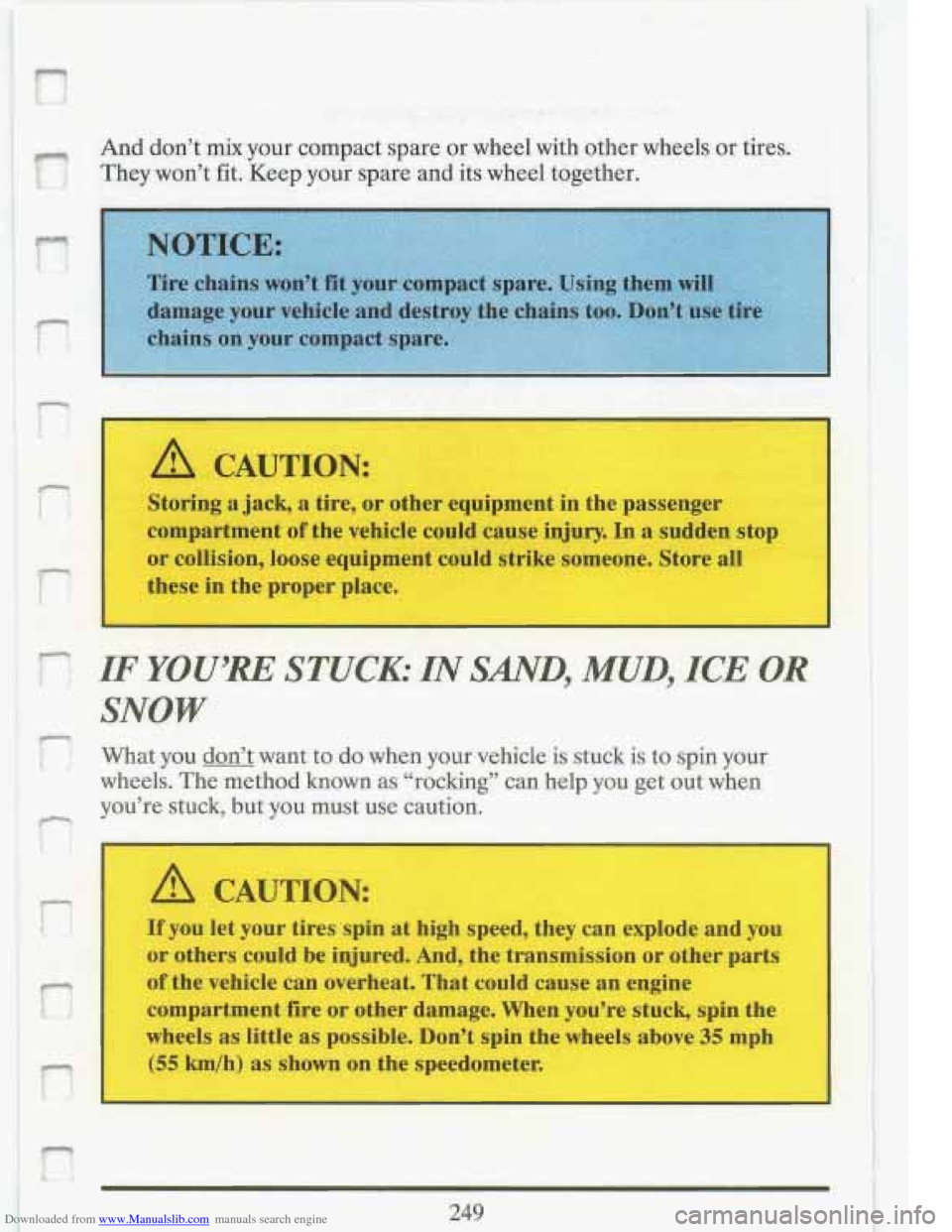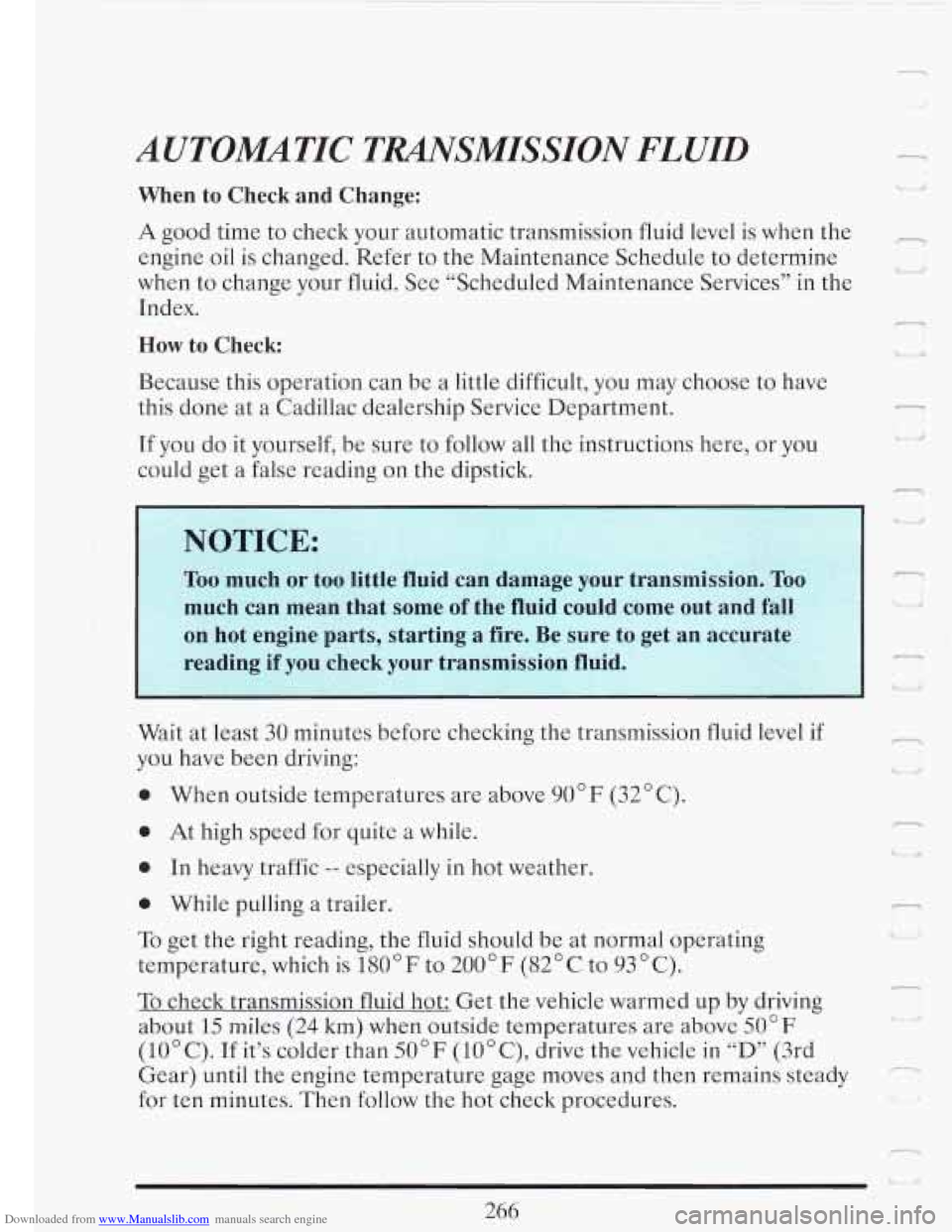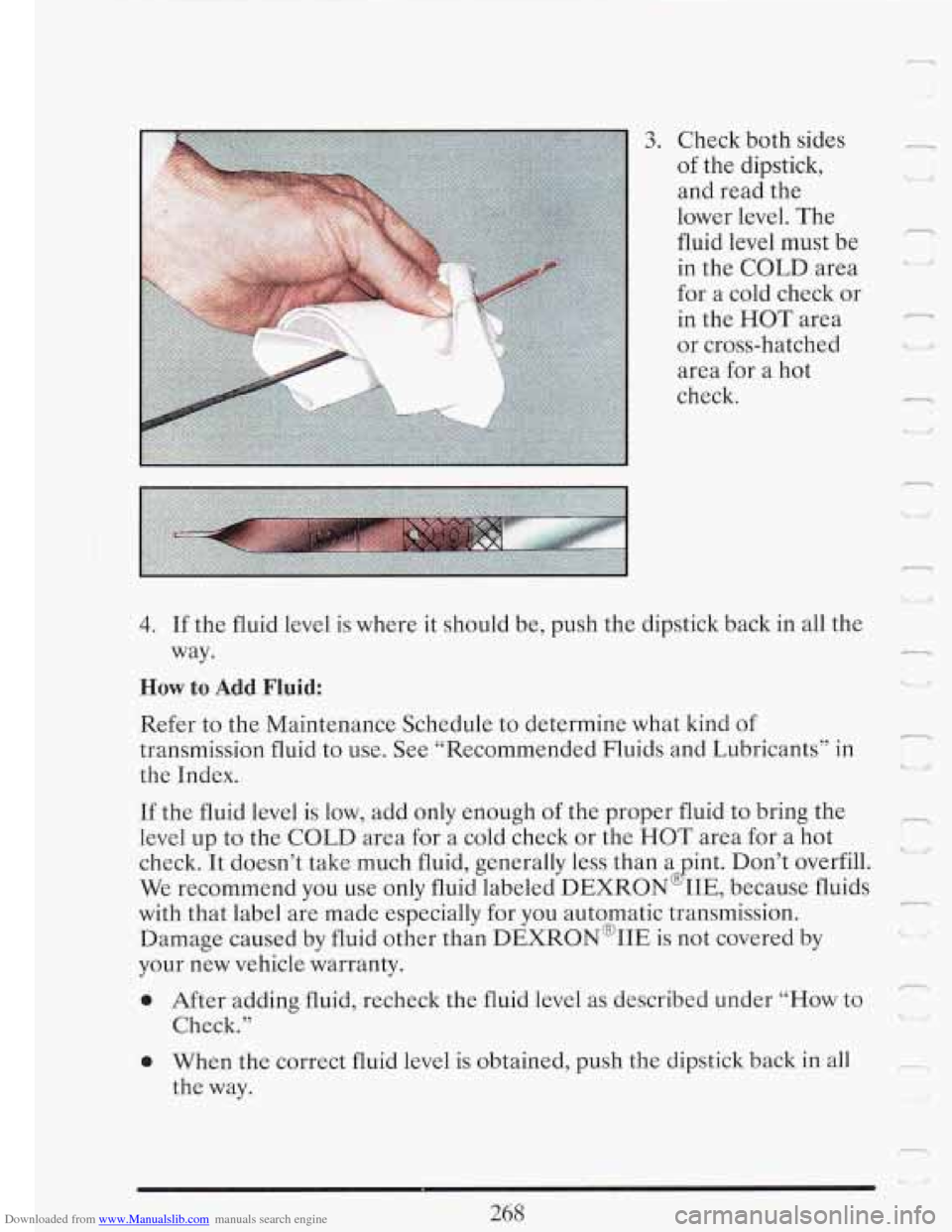Page 229 of 386
Downloaded from www.Manualslib.com manuals search engine - Maintenance when Trailer Towing
Your vehicle will need service more often when you’re pulling a trailer.
See the Maintenance Schedule for more on this. Things that are
(don’t overfill), engine oil, axle lubricant, belt, cooling system, and brake
adjustment. Each
of these is covered in this manual, and the Index will
__- help you find them quickly. If you’re trailering, it’s a good idea to review
these sections before you start your trip.
Check periodically to see that all hitch nuts and bolts are tight.
rc-.- especially important in trailer operation are automatic transmission fluid
215
Page 233 of 386
Downloaded from www.Manualslib.com manuals search engine - TO JUMP START YOUR CDILLAC:
1. Check the other vehicle. It must have a 12-volt battery with a negative
ground system.
- 2. Get the vehicles close enough so the jumper cables can reach, but be
sure the vehicles aren’t touching each other.
If they are, it could cause
a ground connection you don’t want. You wouldn’t be able to start
your Cadillac, and the bad grounding could damage the electrical
systems.
r
A CAUTION:
I You could be injured if the vehicles roll. Set the parking brake
firmly on each vehicle. Put an automatic transmission in
“P”
(Park) or a manual transmission in “N” ‘Ye1 ’ ,alj.
I -
3. Turn off the ignition on both vehicles. Turn off all lights that aren’t
needed, and radios. This will avoid sparks and help save both
batteries. And it could save your radio!
219
Page 238 of 386
Downloaded from www.Manualslib.com manuals search engine When the towing service arrives, let the tow operator know that this
manual contains detailed towing instructions and illustrations. The
operator may want to
see them.
I
.. .
When your vehicle is being towed, have the ignition key off. The steering
wheel should be clamped in a straight-ahead position, with a clamping
device designed for towing service.
Do not use the vehicle's steering
column lock for this. The transmission should be in Neutral and the
parking brake released.
Don't have your vehicle towed on the rear wheels, unless you must.
If the
vehicle must be towed on the rear wheels, don't go more than
35 mph (56
krn/h) or farther than 50 miles (80 km) or your transmission will be
damaged. If these limits must be exceeded, then the rear wheels have to
be supported on a dolly.
224
Page 263 of 386

Downloaded from www.Manualslib.com manuals search engine And don't mix your compact spare or wheel with other wheels or tires.
They won't
fit. Keep your spare and its wheel together.
. - ':.-
'. * , F, . - ;,:: .-
Storing a jack, a tire, or other equipment in the passenger
compartment of the vehicle could cause injury. In
a sudden stop
or collision, loose equipment could strike someone. Store
all
these in the proper place.
,.-IF YOU'RE STUCK: IN SAND, MUD, ICE OR
at you don't want to do when your vehicle is stuck is to spin your
wheels. The method known
as "rocking" can help you get out when
Tw're stuck, but you must use caution.
A CAUTION:
If you let your tires spin at high speed, they can explode and you
or others could be injured. And, the transmission
or other parts
of the vehicle can overheat. That could cause an engine
compartment fire or other damage. When you're stuck, spin the
wheels as little as possible. Don't spin the wheels above
35 mph
(55 km/h) as shown on the speedometer.
I
i
Page 264 of 386
Downloaded from www.Manualslib.com manuals search engine L Rocking your vehicle to get it out:
a’ I
First, turn your steering wheel left and right. That will clear the area
around your front wheels. Then shift back and forth between
“R7
(Reverse) and a forward gear , spinning the wheels as little as possible.
Release the accelerator pedal while you shift, and press lightly on the
accelerator pedal when the transmission
is in gear. If that doesn’t get you
out after a
few tries, you may need to be towed out. If you do need to be
towed out, see “Towing Your Cadillac” in the Index.
--
250
Page 280 of 386

Downloaded from www.Manualslib.com manuals search engine AUTOMATIC TMSMISSION FLUID
When to Check and Change:
A good time to check your automatic transmission fluid level is when the
engine oil is changed. Refer to the Maintenance Schedule to determine
cpr
when to change your fluid. See “Scheduled Maintenance Services’’ in the
Index. -I
How to Check
BeC’%’uSe this operation can be a little difficult, you may choose to have
this done at a Cadillac dealership Service Department.
r IYI
”I If you do it yourself, be sure to follow all the instructions here, or you
could get a false reading on the dipstick.
p_
NOTICE:
I
Too much or too little fluid can damage your transmission.
much can mean that some of the fluid could come out and fall
on hot engine parts, starting
a fire. Be sure to get an accurate
reading if you check
your transmission fluid. I
l-
Wait at least 30 minutes before checking the transmission fluid level if
you have been driving:
0 When outside temperatures are above 90” F (32” C).
n !‘ b
0 At high speed for quite a while.
0 In heavy traffic -- especially in hot weather.
0 While pulling a trailer.
To get the right reading, the fluid should be at normal operating
temperature, which is
180°F to 200°F (82°C to 93OC).
To check transmission fluid hot: Get the vehicle warmed up by driving
about
15 miles (24 km) when outside temperatures are above 50°F
(10°C). If it’s colder than 50°F (lO°C), drive the vehicle in “D” (3rd
Gear) until the engine temperature gage moves and then remains steady
-
for ten minutes. Then follow the hot check procedures. t3
_L-
1 <- 1
266
Page 281 of 386
Downloaded from www.Manualslib.com manuals search engine n To check transmission fluid cold: A cold check is made afte.r the vehicle
has been sitting for eight hours or more with the engine off and is used
only as a reference. Let the engine run at idle for five minutes if outside
temperatures are
50°F (10°C) or more. If it’s colder than 50°F (lO°C),
you may have to idle the engine longer. A hot check must follow when
fluid is added during a cold check. .-
To check the fluid hot or cold:
0 Park your vehicle on a level place.
Place the shift lever in “P” (Park) with the parking brake applied.
__
With your foot on the brake pedal, move the shift lever through each
gear range, pausing for about three seconds in each range. Then,
position the shift lever in
“P” (Park). ~
0 Let the engine run at idle for three minutes or more.
Then. without shutting
off the engine! follow these skgs:
2. Push it back in all the way, wait three seconds and then pull it back out
again.
267
Page 282 of 386

Downloaded from www.Manualslib.com manuals search engine 3. Check both sides
of the dipstick,
and read the
lower level. The
fluid level must be
in the COLD area
for a cold check or
in the HOT area
or cross-hatched area for a hot
check.
r
i4
I’
n i; U
4. If the fluid level is where it should be, push the dipstick back in all the
way.
How to Add Fluid:
Refer to the Maintenance Schedule to determine what kind of
transmission fluid to use. See “Recommended Fluids and Lubricants” in
the Index.
If the fluid level is low, add only enough of the proper fluid to bring the
level
up to the COLD area for a cold check or the HOT area for a hot
check. It doesn’t take much fluid, generally less than a
int. Don’t overfill.
We recommend you use only fluid labeled
DEXRON IIE, because fluids
with that label are made especially for you automatic transmission.
Damage caused
by fluid other than DEXRON@IIE is not covered by
your new vehicle warranty.
8
0 After adding fluid, recheck the fluid level as described under “How to
Check.”
0 When the correct fluid level is obtained, push the dipstick back in all
the way.
n I L> Y
r
Ll
I
r.
- I ‘1